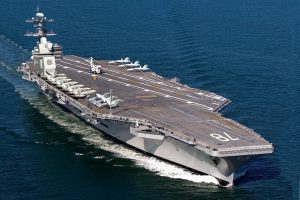I enjoyed watching the commissioning ceremony for the USS Gerald R. Ford (CVN-78) on TV over the weekend. The news media consensus is… it’s big. Really BIG. President Trump’s commissioning speech showed uncharacteristic restraint by not calling the ship yuge.
One memorable episode in my Navy career was a visit to the USS Carl Vinson (CVN 70) in the 1980s. Carriers were a novelty to me because my sea duty was aboard one of the Navy’s smallest ships, a coastal minesweeper with a crew of 35. When I told people aboard the Vinson that my first ship displaced 400 tons, I was told: “That’s about how much we eat.”
Carriers, nicknamed “bird farms,” are as crowded as they are gigantic. Take a two-acre aircraft hangar, put a 4.5-acre airstrip on top and build a ship around it. Add all the equipment and supplies needed to operate the ship and its aircraft, and squeeze 5,000 people into whatever space is left.
Every deck, or level, is a maze of compartments and passageways. The Navy gives each compartment a numerical “address” that indicates its deck, fore-and-aft frame number and port-or-starboard location. Because it’s easy to get lost, floor-plan maps of each deck are posted prominently. When I visited Vinson some prankster had removed the “you are here” stickers.
President Trump described Ford as 100,000 tons of U.S. territory but carriers don’t operate alone. A carrier battle group includes cruisers, destroyers and submarines: not to protect the carrier, as they did in World War II, but to form an integrated system that can detect and defeat anything within a radius of several hundred miles, from the ocean floor to the stratosphere. Think of it as the world’s largest safe space.
The wonder of an aircraft carrier is its ability to launch and recover airplanes. I arrived aboard Vinson on the COD (carrier onboard delivery), a C-2 Greyhound turboprop transport with about 20 passengers. Before takeoff in San Diego we donned helmets and life jackets, and strapped into rear-facing seats in the windowless passenger cabin.
Landing on a carrier requires catching a cable stretched across the ship’s deck with a hook on the aircraft’s tail to drag the aircraft to a stop within a few hundred feet. It took us three tries. We were waved off the first time because the wingtip of a parked airplane was intruding into the landing area. The second attempt was a “bolter.” The tailhook missed the cable – we could hear it bumping along the deck – and the pilot hit the throttles and took off again. The hook caught the third time and we were pressed into our seats as the aircraft went from 145 mph to a dead stop in a few seconds.
Landing on the deck of a ship is an unnatural act for both aircraft and aviator. Every pilot has to re-qualify at the beginning of every cruise, and every landing is recorded on video, critiqued and graded. Every landing is assisted by a landing signal officer (LSO), an experienced aviator who guides the pilot down or waves him off. LSOs stand on an open platform at the edge of the flight deck uncomfortably close to landing aircraft.
When I visited there my guide pointed out a padded ramp several feet below the platform, where the LSO’s can jump if an errant aircraft heads for them. “If you see the other guys jumping, you jump too,” I was told. “But if you’re the first one to jump the other guys will land on top of you.”
The orchestrated chaos of the flight deck, and the care and feeding of 75 aircraft, are only part of what goes on aboard a carrier. It’s a floating city with a hospital, a police force of Marines, food service, laundry, gym, brig (jail) and even a TV station. Not to mention advanced electronics and a nuclear power plant.
It’s a city of youngsters with an average age of 24. The men and women fueling and maintaining the aircraft are in their teens. The aviators are in their twenties, and the squadron commanders and senior enlisted people are in their thirties.
My tour of the Vinson included clambering down into the bowels of the ship to see a pump room of some sort. Ships have lots of places like this: neat, utilitarian arrays of well-oiled machinery. But in this one the sailors decided to polish the equipment to a parade-ground sheen and transform an ordinary pump room into an immaculate showplace. Because it was theirs.
Departing a carrier is just as dramatic as arriving. The aircraft is hitched to a catapult driven by a hydraulic ram, and is held in place as the pilot revs up the engines. When maximum power is reached the catapult yanks the aircraft forward and flings it into the air. As my transport flight was launched we levitated against our seat harnesses for a moment and two young crew attendants let out a joyful whoop. It’s a rush and yeah, it’s fun!

